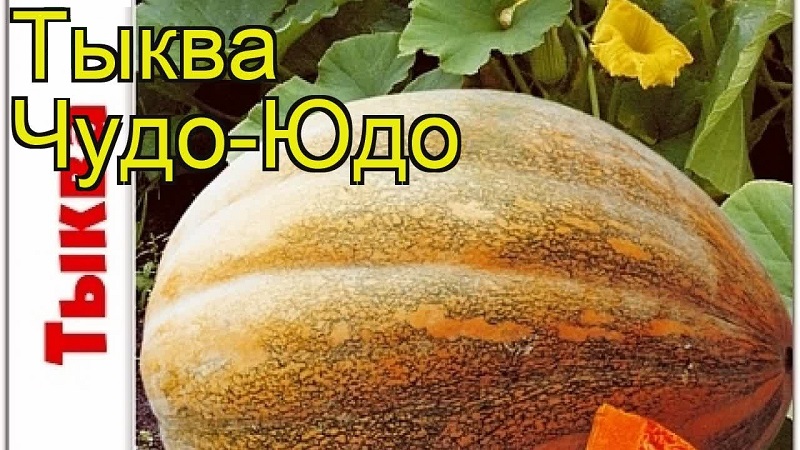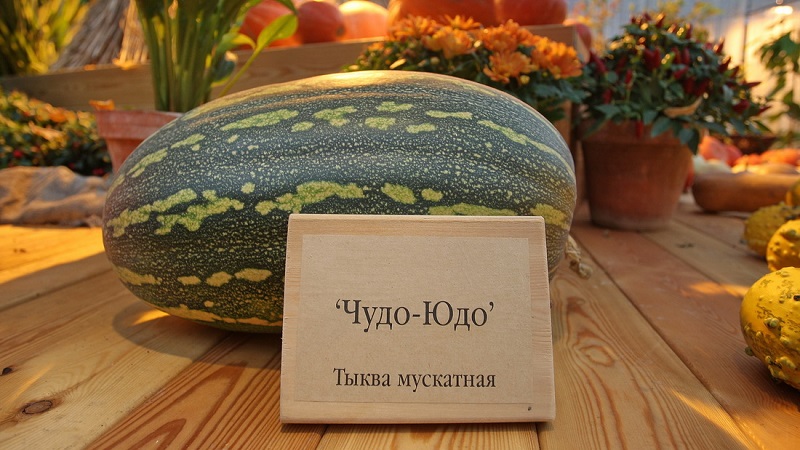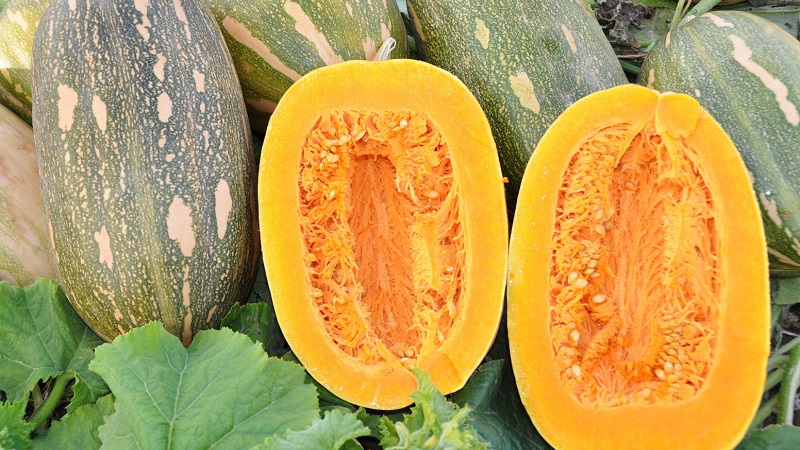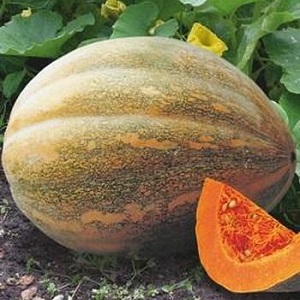Chudo Yudo nutmeg pumpkin: a unique variety for long-term storage and preparation of delicious dishes
Among the varieties of pumpkins, nutmeg considered the sweetest. It got its name from the original taste of the fruit. Many housewives prepare various dishes from the Chudo-Yudo nutmeg pumpkin: pies, cereals, sweet soups. We will tell you how to grow nutmeg pumpkin, and what to cook from it.
The content of the article
Description of the variety Chudo-Yudo
Miracle Yudo has a nutmeg smell. The pulp is sweeter than regular pumpkin. Excellent taste.
Miracle Yudo is widely used for medicinal purposes: vegetable pulp acts as a diuretic, increases the elasticity of blood vessels and cleanses them. Pumpkin has a beneficial effect on the body with hypertension, heart disease, cholecystitis, and helps to fight excess weight.
Distinctive features
Pumpkin of this variety can be processed into juice, baked, canned, used fresh in salads. The fruit has a high carotene content - 25.5%. The sugar content is 4.25%.
Fruit characteristics
The plant is long-leaved, powerful. The leaves are pentagonal, dark green. The oval fruit is slightly segmented, the bark is orange in color with a gray bloom and a mesh pattern. The vegetable's bright orange flesh contains red streaks.
Did you know? The homeland of the pumpkin is South America. On the territory of Mexico, the Indians began to cultivate the culture 5 thousand years ago.
Yield
It takes 120 days from germination to ripening of a vegetable. The average weight of one pumpkin is 6-8 kg, but with good soil fertilization it reaches 20 kg or more. The pumpkin is perfectly stored in the winter.

How to grow
The easiest way to grow a pumpkin is by direct sowing in open ground. Only the largest seeds are taken for sowing. The selected seed is properly prepared.
Seed preparation
Germination is the best preparation of seeds for sowing. This procedure is continued until the seeds hatch. To do this, the grains are placed in water with a temperature not lower than + 40 ° С and not more than +50 ° С. In this state, the seed is left for 3-4 hours.
Council. It is best to put the seed bowl on a radiator or other heat source.
After soaking grains wrapped in a wet cotton cloth and left at room temperature until the sprouts hatch. The fabric is periodically checked and moistened without drying out.
Since pumpkin is a heat-loving plant, it is recommended to harden the seeds before planting. To do this, naklyuvannye grains are also kept in a damp cloth in the lower drawer of the refrigerator for 3 to 5 days.
Sowing in the ground
Before sowing pumpkin seeds outdoors, make sure no more frost is expected. Pumpkin is a heat-loving plant; seeds may not grow in cold soil.
The pumpkin is planted at the end of the frost, as soon as the air temperature rises to +18 ° C. Sowing is carried out in May, when the soil at 7-8 cm depth warms up to 12-13 ° C.

Growing seedlings
Seedlings are grown for an early and abundant harvest. Not necessarily at home - this can be done in a nursery or mini-greenhouse. But the best place for the plant would be a windowsill on the south side of the house.
To grow seedlings, you will need peat-peat or ordinary pots at least 10x10 cm in size. Seedlings should be kept in a pot for at least three weeks before transplanting to a permanent place.
Sprouted hardened seeds are sown two seeds per pot. Planting depth - 2 cm. Seeds are covered with peat. Watering is carried out before and after sowing. The first three days, crops are kept at a temperature not lower than + 25 ° C.
On the fourth day after germination, weak seedlings are removed by simply pinching off the stem. The air temperature is lowered and maintained within +18 ° C so that the seedlings do not stretch out and grow strong.
Watering the seedlings is carried out regularly, but without excess moisture. Stagnant water leads to root rot. Perfect watering and adequate humidity will make the plant hardy.
Two weeks after the emergence of seedlings, top dressing is carried out. To do this, the mullein is stirred in water (1:10) and each plant is fertilized with the resulting solution, 100 ml after watering. If the mullein is not present, it can be replaced with nitrophos. Top dressing is carried out according to the instructions.
Care
Regardless of the planting method, the plant needs proper care:
- watering;
- loosening;
- top dressing;
- topping;
- weeding.
The pumpkin is watered with warm water (about + 20 ° C), the optimal volume is 6-7 liters per plant or 15-20 liters per sq. m. Before the ovaries begin to form, watering is carried out once a week, and in the future - once every two weeks. After each moistening, the soil around the plants is loosened.
Fertilizers increase the yield of the variety and the quality of the fruit. After the formation of the fifth true leaf, the first feeding with nitrofos is carried out. In the lash formation phase, a second feeding is carried out with a mullein solution. During the flowering period, the pumpkin is watered with warm water with the addition of ash.
Weeding is important for the lashes to form properly. When they are formed, the need for this procedure will disappear.
For your information. It is not recommended to move the formed whips and knots, especially during the flowering period. There is a risk of damaging the flowers and stopping the development of the fruit.
Pinching is carried out so that 4-6 leaves remain over each young vegetable. It is recommended to leave 3-4 ovaries. Experienced vegetable growers advise pruning in different ways: leave one plant with one stem, the other with two, and so on.
Features of cultivation and possible difficulties
In relation to the climate and soil conditions, butternut squash is a rather unpretentious plant, so even a novice gardener can handle the cultivation of this vegetable. However, to obtain healthy fruit-bearing bushes, it is necessary to create an optimal microclimate.
At the seedling stage, young bushes look strong, but the seedlings do not tolerate picking well.Therefore, the plant is grown in peat cups or tablets.
The time of landing in open ground depends on the climate of the area. In the northern part of Russia, favorable for sowing days are in early June.
Residents of the southern regions plant seeds outdoors in mid-May. Some gardeners in the southern part start sowing from May 10. Those who live in the middle lane have been sowing pumpkin in open ground since May 25.
Important! According to popular beliefs, the best day for planting a pumpkin is Yuri's day, in the morning. If circumstances do not allow you to plant seeds on this particular day, do not be upset. A pumpkin planted in moist, warm soil enriched with fertilizers will yield an excellent harvest, regardless of the day of planting.

Growing tips from experienced gardeners
Summer residents recommend planting seeds in small mounds. This will make the pumpkin grow better. Create a hillock about 3 cm high for each plant, leaving a distance of about 1 m between them. In each mound 1 cm deep, plant 4-5 pumpkin seeds. Cover the seeds with soil and press down lightly around.
After the seeds germinate, thin them out so that 2-3 strong shoots remain. If you are replanting pumpkin seedlings, plant each plant in a separate mound.
Let the shoots of culture not on the ground, but on a support.In order for the pumpkin to grow vertically, put a post at each mound. Once the shoots have sprouted, gently wrap them around the base of a support or post.
For your information. If the leaves are shading the pumpkin, trim them carefully.
To protect the growing plant, mulch the soil. Lay out pine needles or other lightweight mulch so the plant doesn't touch the dirt and moisture stays in the soil longer.
Diseases and pests
To protect the crop from diseases and pests for prophylactic purposes, the plant is treated with biofungicides or growth-stimulating agents - these are Krezacin, Silk, Epin and Immunocytofit. Also, bushes can be sprayed with "Kurzat" or "Acrobat".
Despite preventive measures, the culture can be affected by various diseases and pests.
Anthracnose
Most often, the disease affects the pumpkin that grows in the greenhouse. Symmetrical leaf and stem lesions are formed. Spots with pink bloom appear on the surface. When the roots are damaged, the plant dies. The disease is actively developing with high humidity. It can also appear during a hot period when watering.
Powdery mildew
It appears due to a sharp drop in night or day temperature. Spots appear on the fruits, the foliage turns yellow, dries up and falls off. To prevent powdery mildew at night, the plant is covered with a film. Watering the crop regularly is also important.
Ascochitosis
Affects ground parts of the plant due to high humidity or frost. Black spots appear on fruits, stems and leaves. To prevent disease, the seedlings are covered with foil.
Melon aphid
The insect sucks out all vital juices, subsequently the foliage dries up from a lack of moisture and nutrients. To combat aphids, special preparations or folk remedies are used, for example, an infusion of wormwood or chamomile. You can also get rid of pests with ash, as well as tomato or potato tops.
Slugs
These pests lay eggs in the soil and eat the fruits at night, leaving holes in the vegetables. In the fight against them, the site is fenced with burlap and even burdock is planted next to the plant. In the daytime, slugs will accumulate under the burlap, and in the evening they can be exterminated with ash.
Harvesting and application of the crop
The crop is harvested from mid-August until the onset of autumn cold weather. This is done by carefully cutting the fruit, leaving a 5 cm tail.
The harvested crop is dried for two weeks, then harvested in a dry place. If you plan to consume the pumpkin immediately after harvesting, it is given several days to fully ripen, acquire a special taste and orange color.
The Miracle Yudo nutmeg pumpkin is easily digestible, strengthens the immune system and relieves the condition in case of kidney and liver, exerting a choleretic effect. Vegetables are used to make pies, salads, porridge, various soups, juice and many other dishes.
Advantages and disadvantages of the variety
 It is more difficult to grow the nutmeg variety Miracle Yudo in the open field than zoned pumpkins. The culture is demanding on good nutrition and the length of daylight hours, does not tolerate shade.
It is more difficult to grow the nutmeg variety Miracle Yudo in the open field than zoned pumpkins. The culture is demanding on good nutrition and the length of daylight hours, does not tolerate shade.
If the growing rules are violated, the fruits will develop poorly, some vegetables may rot, and those that have time to ripen will grow with small undeveloped seed boxes.
Although the variety has its disadvantages, there are much more advantages:
- The shell is thin, but dense, the vegetable is covered with a waxy bloom, which protects the fruit from bacterial rot. Thanks to this, pumpkins are stored in a cool room for up to a year.
- The fruits have a slight smell of nutmegs, which distinguishes them from table varieties.
- The vegetable is equally tasty after heat treatment and raw.
- The pulp contains a large amount of carotene, mineral salts and sugar, due to which the taste after heat treatment turns out to be so rich that it does not require the addition of spices.
Farmers reviews
Many gardeners speak positively about the Miracle Yudo pumpkin:
Daria, Voronezh: “Chudo-Yudo planted pumpkin seeds on May 15 under the covering material - everyone sprouted. Filmed on September 19. The fruits were of different sizes - from 3.3 to 7 kg. The smallest pumpkins were dark orange in color, the larger ones ripened at home. At the end of September, I cut the first small fruit, it turned out to be ripe, very juicy and crunchy. When I cut a medium-sized pumpkin, it turned out to be very juicy, bright orange (hands were red). Everyone liked the baked vegetable - they ate it in one go. With minimal maintenance, the pumpkin has shown itself to be very productive, next year I will grow it again. "
Vladimir, Ivanovo: “Of course, Chudo-Yudo is not the earliest variety, but very tasty. I planted seedlings late - in early May. From three seeds all sprouted. June was wet and cold. The plant was tied well, but everything rotted away. And in July it was sunny, and then I left 2 fruits on each plant. The crop took off on the 20th of September. As best it could, the pumpkin ripened at home. The largest weight was 7.8 kg. The vegetable has a pleasant fruity taste. "
Ekaterina, Pskov: “At the beginning of April, I sowed Miracle Yudo for seedlings in a liter package, then on May 5, I transplanted the seedlings under the covering material. The fruits grew beautiful, as in the photo of the package, the largest weight reached 11 kg. I made candied fruits out of them. It seems to me that of the nutmeg varieties, Miracle Yudo is the sweetest pumpkin. She has a very pleasant smell. "
Conclusion
In addition to its excellent taste, the Miracle Yudo butternut squash has a long shelf life due to its waxy coating. The vegetable contains a large amount of vitamins and minerals. Pumpkin fruits can vary in shape, but have a thin skin that is easy to cut.
It is not difficult to grow Miracle Yudo, since the variety is not capricious. The main thing is to choose an unshaded place, water and feed the plant in a timely manner, as well as carry out prevention against pests and diseases.